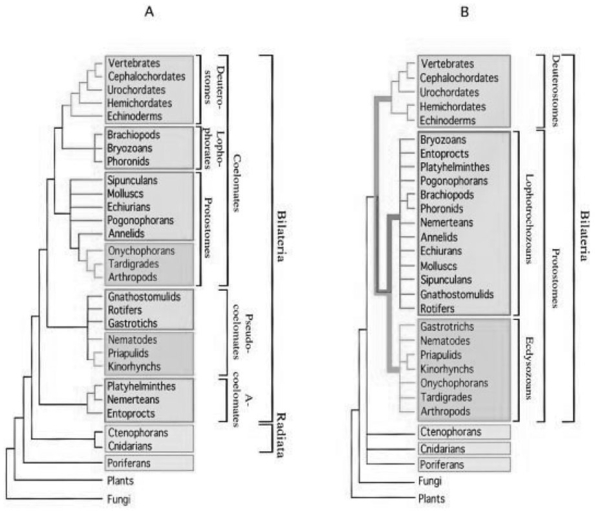Multiple Choice
Use Figure 30.3 and the following information when answering the next question.
In a review paper published in 2000, Adoutte et al. examined some animal phylogenies generated by comparing the ribosoma rRNA) of animals from many different phyla. They then integrated these independently created phylogenies into one phylog best fit all the data.
Figure 30.4 compares a traditional phylogeny based on morphological characteristics A) to the new molecular- based phylog described by Adoutte et al. B) .
Note that platyhelminthes, nemerteans, and entoprocts, which do not have coeloms and are classified as acoelomates in the morphological phylogeny, are reclassified as lophotrochozoans in the molecular phylogeny. Similarly, groups classified as pseudocoelomates in the morphological phylogeny are reclassified as either lophotrochozoans or ecdysozoans in the molecula phylogeny; other lophotrochozoans and ecdysozoans have coeloms.
A. Adoutte, G. Balavoine, N. Lartillot, O. Lespinet, B. Prud'homme, and R. de Rosa. 2000. The new animal phylogeny. Figure 30.3
Figure 30.3
-What does this reclassification based on molecular data imply about the evolution of acoelomates, pseudocoelomates, and coelomates?
A) Pseudocoelomates can be seen as an intermediate stage between acoelomate and coelomate development.
B) Some pseudocoelomates and acoelomates have evolved from coelomates.
C) Although acoelomates and pseudocoelomates evolved only once, coelomates evolved multiple times in different lineages.
D) Only the animals that evolved earliest are acoelomates.
Correct Answer:

Verified
Correct Answer:
Verified
Q31: Which tissue type, or organ, is not
Q32: <img src="https://d2lvgg3v3hfg70.cloudfront.net/TB6548/.jpg" alt=" Figure 30.2 -Which
Q33: Which feeding tactic is most associated with
Q34: What would an adult animal that possesses
Q35: Which reproductive strategy is facilitated by i.e.
Q37: Bilateral symmetry is advantageous primarily because it
Q38: Although our current understanding of why coral
Q39: Suppose all of the suspension feeders were
Q40: Which one of the following objects most
Q41: Which of the following feeding tactics is